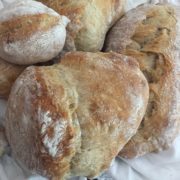Alentejo Homestyle Bread
Alentejo Homestyle Bread is the bread of my heritage. When my father opened a bakery here in the United States, this is one of the types of bread he made. Here the measurements are given in grams not volume. If you do not have a prepared sour dough starter available, you can purchase and substitute a 250 gr bread dough from a bakery. A digital scale is perfect for baking by weight . This recipe for Alentejo Homestyle Bread can be cut in half. If you have a double wall-oven, a second baking stone is great to have. Alentejo Homestyle Bread is not only easy to make but, it is so delicious! For cold retardation, read step 12. Read the recipe through before starting.
Makes 2
Total flour is 700 g about 78% hydration
Premix:
50 gr dark rye flour
200 gr bread flour (12%)
300 gr water
Remaining Ingredients:
250 sour dough starter (100% hydration), room temperature
165 gr. bread flour
160g rye dark rye
3 1/2 g dry instant yeast
120 ml water
14 g table salt
rice flour for shaping as needed
Some Equipment:
one 12 -quart Dough rising bucket with lid, available at restaurant supply stores or other food safe container with lid or plastic wrap
digital scale baking stone or
pizza stone
stand mixer
Method:
1. In a large bowl, sift together the rye and bread flours until they are well-blended. Gradually, stir in the 300 ml water and lightly mix. Let stand covered for about 1 hour to autolyze.
2. Into the bowl of a stand mixer, combine the starter or bread dough with the autolyzed flour and water and mix to combine. Then, scatter the dry yeast over. Add the remaining flour and pour in the all but 1/4 cup of the remaining water.
3. Set the mixer on low and mix until the ingredients are becoming well blended. Gradually, increase the speed to medium-low, mixing until you see the dough starting to come together.
4. Mix the salt in the remaining 1/4 cup of water and add. Increase the speed to medium, letting the machine kneading dough, about 7-10 minutes more. Finally, When you see the dough has pulled away from the sides of the bowl, leaving the bowl” clean”, the dough is ready. The dough should have somewhat of a satiny sheen.
5. Moisten a clean work space with water. Moisten your hands with water and pull the dough out from the bowl onto the wet workspace.
Kneading by stretching and folding
6. .When mixing by machine, the machine does the kneading for you. If you mixed by machine, skip to step 3 and do the coil folds as directed. If you mixed the dough by hand, knead the dough using the stretch and fold method as follows:
7.. Keeping your hands moist and rewetting the workspace surface as needed, shape the dough into a large round. Grab 1/3 of the dough and pull it outwards to stretch it and then flip-fold it back onto itself on the workspace. Repeat all around the dough. Re-wet your hands as needed. Repeat the stretch and fold 2 more times, 30 minutes apart.
8. After the last stretch and fold, do 3 coil folds, 30 minutes apart: Using both hands, reach under the upper middle of the dough, picking up the dough, stretching it up and then letting it back down “coiling” under itself. Do this on north, east, south and west of sides of the dough. Do not rush this process. Rest for 30 minutes.
9. After the last coil fold, place the dough into a dough rising bucket or a a large bowl , covered with plastic and let rise about 1 1/2 hours. At this point after rising, you can divide and pre-shape, rest it for 15 minutes, shape and let rise for 1 1/2 hours, then bake the same day.
10. Lightly flour your work space with rice flour. With floured hands, turn the dough out onto the space. Gently working, divide the dough into approximately 2 even pieces. Shape each piece into large rounds or ovals and transfer upside down to a well- rice floured banneton , or wooden board. Cover and let rise about 3/4 hour.
11. Set the baking stone in the oven on the middle to lower middle shelf- not the bottom. Preheat the oven to 475 ºF for at least 30 minutes.
12. For myself, I prefer to do a cold retardation of leaving the shaped dough in the refrigerator for 24 hours. The next day, With a preheated oven, I bake the bread directly from the refrigerator to the oven, after removing the bannetons. Cold retardation gives the bread more flavor.
Shaping Notes
While you can shape Alentejo Bread in just in a simple round or oval shape, the following is more traditional. When the oven is ready, take a round of dough and using the side of your hand and forearm, make an indentation across 1/3 of the round. Fold the smaller part of the dough up and over onto the rest of the round, pressing the edges to hold.
Lightly flour the wooden oven shovel with rice flour or corn meal, and transfer the bread dough right side up onto the shovel. Open the oven door and slide it onto the hot stone. Quickly repeat with the remaining dough. Bake for 40-45 minutes. The bread should have a hollow sound when knocked on the bottom. Let cool 15 minutes before slicing. Internal temperature should be at least 184 degrees F. to 200 F.
Note: You can also bake in a preheated covered cast iron pot. Transfer the dough right side up onto parchment paper and carefully transfer to the preheated pot. Twenty minutes covered and remaining 25 minutes uncovered.
To store additional loaves in the freezer, completely cool and then double wrap or place in freezer bags, pushing excess air out. To refresh, thaw at room temperature and reheat in a preheated oven at 300 °F for about 15-20 minutes.









